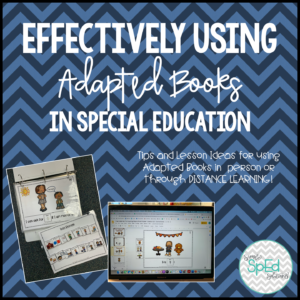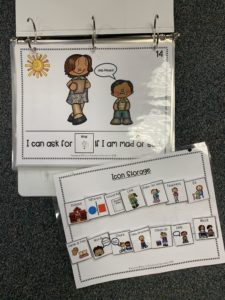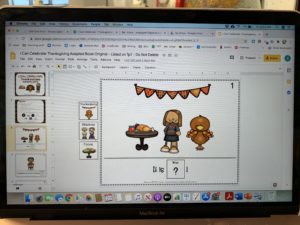
Most Special Educators or Early Educators (Pre-K/K/1) teachers I know LOVE a good adapted book. But what do you do with these things? Just read them? Set them in front of your student and hope they participate?
Like most things with our students, the engagement with these books must be taught, but once you teach it, these adapted books are an awesome tool to help build vocabulary, increasing sentence length, or even as an engaging social story to help practice and learn behavior basics.

How to Teach with Adapted Books:
There are a few ways you can practice and increase your student engagement with these books. When first introducing them to my students or with my lowest level learners, I will give errorless choices in a small group setting. For example, I present the page and read the sentence while filling in the blank with the word. Then I may ask “Who has the word “Yes!” The student will respond by handing over the icon to finish the sentence or placing it on the blank themselves if they are able.
I also can use these books in a 1-1 setting, even with students who need 1-2 choices. For example, when I used these books with students with MD who had limited arm movement, I would present the page to the student and read aloud. Then I would ask the student which word (icon) fits in the blank. I could place the icons farther apart on a choice board and have the student either move their arms or head to indicate which choice (also works for students who use eye gaze choices!)
In a larger group, you can give each student 1-3 icons to ‘hold onto’ for you. When you come to a blank you can either fill it in verbally and then ask “who has ___”. The students must look at their icons, determine if they have the correct one to fill in the blank, then raise their hand, and engage to answer! (That’s like 4 different skills with 1 activity)
Students can also use these independently or in centers. You can simply collect all icons on one page *icon storage pages are provided in my books* and have the student go through the book, matching the correct icon to each page.
What can you learn with adapted books?
There are 3 types of Adapted Books that I create:
Social Story/Behavior Basics
These books are the ones I use most often in my large groups. These books are written in the first or second person to create a social story feel and go over specific situations. The adapted nature of the books allow students to choose their response. Some of my favorites include: Our Recess Rules (practicing appropriate behaviors on the playground) and I Can Make Friends (social skills for making friends).
These also include specific scenarios that may be more difficult for our students, such as Fire Drills, Lockdown Drills, and Celebrating Holidays. They walk students through the scripts of what things in their environments may change and what to expect. Going over differences in routines and expectations before the event can drastically reduce the chance of problem behaviors!
Specific Skills
Occasionally I will make books to target specific skills. Books like the What, How Many, What Color practice skills of IDing Colors and animals, and counting to ten. The What is Where book used items to practice common positional prepositions such as IN, ABOVE, ON, UNDER, etc!
Informative/Lessons
The last type of book I create are ones that are intended to tell a story or lesson about a person or event. For example, our Black History Month series teaches about the lives of Ruby Bridges, Martin Luther King Jr, and Rosa Parks in an interactive and accessible way. The Community Helpers books teach lessons on types of helpers and their tools.
Once you determine your target teaching goals and pick your book, you can choose whether to use the book as a physical book or digital activity. (This is my adapted book library, we do not have a binding machine so I keep them in binders!)

I had always used my adapted books as physical books for students who may need physical and visual icon choices, so when we moved to distance learning, I was hesitant to modify my books for use in my online classroom. However, I am SO glad I took that plunge. It took some time, but now we use adapted books ALL the time and we’re still full distance learning. If you have purchased one of mine in the past, you can re-download to get the Google Slides link for FREE!
One of my favorite ways to use them during ZOOM lessons (or Google Meets) during our speech consults. My SLP loves to see the students using the images to increase their sentence length and learn new vocabulary words.
First, I will share my screen with a small group. I have placed 3 icons on the side of every page in the adapted book, one correct and 2 incorrect icons to choose from. You can copy and paste to add more or remove to create fewer choice options depending on the level of your students. I will read through the sentence and ask the student to choose which icon fits in the blank. If the student can read on their own, they can! If the student is able to use “remote control” on the ZOOM app and drag it themselves, GO FOR IT! If you want the student to annotate and circle what they think is the correct answer, DO IT! The possibilities really are endless and they are so easy to adapt to each child’s learning needs.
Don’t forget to browse my Adapted Book library HERE.

Did I miss anything?? How do you use Adapted Books in your classroom? Comment below!













